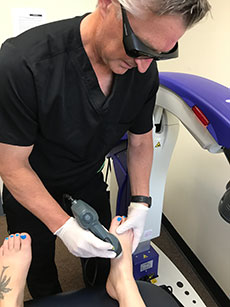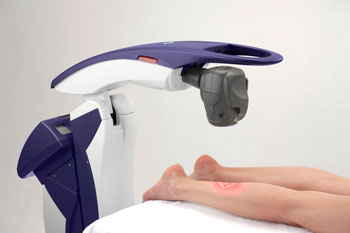MLS Laser Therapy

MLS, or Multiwave Locked System, Laser Therapy is a non-invasive option for patients dealing with foot complications who want to explore treatment options other than surgery. MLS Laser Therapy helps relieve the pain that comes with having strains, sprains, and issues with inflammation. This therapy has been found especially useful for those who experience chronic complications.
Some foot conditions MLS Laser Therapy can treat include Achilles tendonitis, plantar fasciitis, heel pain, bursitis, diabetic neuropathy, and different forms of arthritic conditions. Those who are experiencing pain due to sporting injuries or wounds may also find relief with this kind of therapy.
MLS Laser Therapy is a painless treatment that typically requires a short amount of time to complete, depending on the condition. It not only increases the speed of recovery, but helps improve blood flow and alleviate pain. Improved immune function, as well as improved vascular and metabolic activity, are just some of the benefits of choosing MLS Laser Therapy as a treatment option.
If you’d like more information about MLS Laser Therapy, consult with a podiatrist to determine if you’d be a good candidate.
MLS Laser Therapy FAQs
What is Laser Therapy and how does it work?

Laser Therapy is a therapeutic treatment that uses light energy (photons) for tissue healing and pain reduction. The light energy penetrates deeply into the damaged cells and stimulates cellular activity. Due to exposure to the laser, the cells of tendons, ligaments and muscles repair themselves. Light energy enters damaged cells and stimulates inter-cellular activity. This reduces pain in the area and speeds recovery of the damaged cells. Once the cells recover, the healing process is complete.
What is MLS?
MLS stands for Multi-wave Lock System. MLS is the name of the FDA (Food and Drug Administration) approved technology that utilizes a patented combination of unique wavelengths. The two wavelengths work together to deliver superior results.
How is MLS different?
MLS Therapy uses two wavelengths to overcome the limits of traditional Laser Therapy. Continuous laser emissions act fast on inflammation, stimulating blood and lymphatic circulation and inducing fast re-absorption of fluid build-up; however, they only have a secondary effect on pain which is diminished after reducing the inflammatory process. The MLS pulsed laser emissions on the other hand, have an immediate effect on pain since they can induce analgesia by interfering with the very transmission of the pain impulse to the higher brain centers, but they are less effective at treating inflammation and edema.
What is the advantage of MLS Therapy over traditional low-level lasers? (LLLT)
Until now, there have been only pulsed light lasers that control swelling and continuous light lasers that control pain, but not both. Current traditional laser therapy provides partial treatment at best by reducing inflammation or pain but never at the same time. MLS Therapy can induce strong anti-inflammatory, anti-edema and analgesic effects simultaneously and within a brief time. LLLT cannot achieve these results because of the limitations of using one or two wavelengths that are synchronized. The patented control system that generates the MLS pulse synchronizes the emissions to achieve results previously unattainable. Thanks to this characteristic synchronization, the various therapeutic effects not only take place at the same time but reciprocally reinforce each other.
How was MLS Therapy developed and tested?
MLS Therapy has been developed and tested following strict courses of biomedical and clinical research. The effectiveness of the combination of the emissions making up the MLS pulse was initially tested in vitro on cellular cultures, then in vivo on animals, and finally by means of controlled clinical trials run by major state of the art health organizations for treating traumatic and degenerative pain diseases.
What are the most common indications for therapy?
The most common MLS Therapy indications are pain relief, intervertebral disc disease, degenerative joint disease, arthritic conditions, musculoskeletal system trauma and inflammatory conditions.
What conditions does it treat?
- Neck and back pain
- Tendon and ligament injuries
- Sore muscles, muscle strains and tears
- Degenerative joint conditions
- Neurological and general pain or bruising
- Musculoskeletal disorders
- Pre- and post-surgical treatment
- Anti-inflammation applications
- Specific neurological conditions
What are the benefits?
- No side effects
- Painless and non-invasive
- Drug-free
- Rapid relief of pain
- Strong anti-inflammatory effect
- Timely healing of sprains and strains
- Rapid recovery of the structural integrity of injured regions
- Rapid resolution of swollen areas
- Immediate improvement of local blood circulation
- Rapid repair of superficial injuries, such as wounds and ulcers
What can I expect during treatment?
MLS Laser Therapy is a painless treatment that lasts a few minutes. Some patients have stated they feel a comfortable warm sensation in the area being treated, while other patients usually don’t feel the laser. There is no pain, heat, redness or swelling during or after treatment.
What can I expect after the treatment?
Most patients experience positive results in 1-3 treatments, with the average course being 7-10 sessions. Any swelling is reduced and there is a rapid relief of pain. Acute conditions usually subside quickly, typically within one phase of treatment, and chronic conditions can be controlled with regular treatments. The effects of MLS Laser Therapy are cumulative; therefore, expect to see improvement as you proceed through your treatment pain. It is critical that once you start, you complete the course of treatments recommended by your doctor or symptoms are likely to recur.
